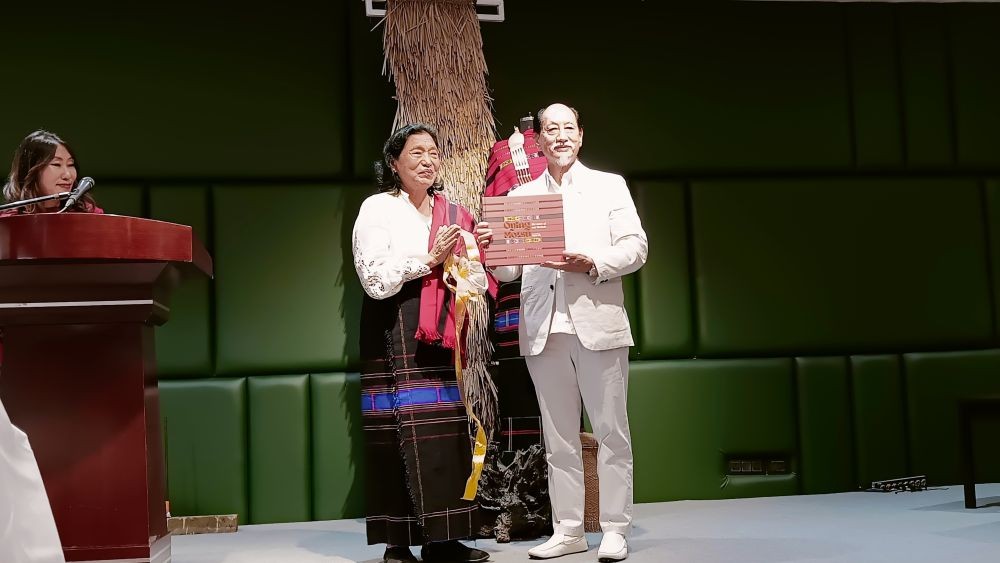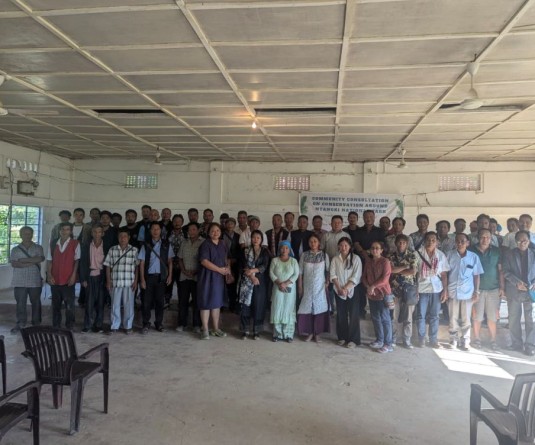Chief Minister of Nagaland, Neiphiu Rio releasing “Oying Motsü- The Story of our threads” by Abeni TCK at Hotel Vivor Kohima on August 29.

Morung Express News
Kohima | August 29
Fulfilling a long cherished childhood dream, Abeni TCK, a distinguished personality & women leader of repute today brought out her memoir titled “Oying Motsü- the story of our threads”. The book was formally released by Chief Minister of Nagaland, Neiphiu Rio at Hotel Vivor Kohima.
Speaking at the launch, she related that, “Oying Motsu, or the Story of our threads, is not just a personal account of my weaving journey but also a testament of the incredible legacy of our ancestors who has carried this art from in tact, from one generation to the next.”
She recalled that her journey with threads began as a small girl, helping and watching her elders weave. This passion led her to design modern weaves of her Lotha tribe as well as rediscover Nagaland heritage weaves and motifs through the Pitt Rivers Museum archives in Oxford London.
Highlighting about exploring new cultural horizons with Queen Angya Likhao of Shangnyu Village of Mon District, she also spoke about embarking on the weaving transformation of Naga Modern designs which took place from 1980’s through the initiative of the NWVA.
Stating that the main part of the book focuses on the heritage, traditional and modern weaves of the Lothas, she highlighted that, “it also centers upon the extraordinary contribution and achievement of our fore-mothers who passed down the skill, designs and purpose for which they wove.”
Although they are no more now, she said, “but we can honour them through our weaving practices and the wearing and the propagation of our traditional art form.”
She underscored that, “We must remember that they have provided the foundation from which we have a lifelong responsibility to innovate and grow its impact and popularity.”
Emphasising that our cloths are not created for functionality alone, she asserted that, “each piece of garment reveal the remarkable thought process of our ancient mothers who took it upon themselves to tell us about our traditions, with each design representing values of that era and the sentiments of the community.”
Underlining that history is remembered because it is recorded and written methodically, she said, “in the weaving narrative of the Nagas, most of what we know has been told orally to us.” Towards this end, she also stressed that with generations passing on, “there is a great need for our written literature to speak on, till posterity, on behalf of the older generation.”
She further acknowledged those who have contributed to the book while describing them “history keepers” and their crucial role as observers, researchers and recorders of our history. The book, she added, is the result of many contributions of five long dedicated years.
‘A story of her people, our tradition of textiles, design & motifs’
Chief Minister of Nagaland, Neiphiu Rio stated that it was a joy to come and celebrate a lifelong achievement of Abeni TCK -a story of her people, our tradition particularly in our textiles, designs our motifs, and the colour combination of each tribe particularly the Lotha tribe.
Although Nagas were illiterate, and no clothes to wear, he remarked that, “whatever we do, we have so many designs and patterns which tell stories of our rich culture and tradition.”
He acknowledged Naga women who weave with the simple tradition of weaving and dyeing and now with fusions of modernity and tradition, he also noted that, “beautiful designs have come.”
He further stated confidence that “the book will go to many homes and inspire many people.” Speaking about Nagaland state, which is known as the Land of Festivals, he remarked that, consecutive governments give protection of our culture and customs.
“The vibrancy of Naga society, the youth, innovation, the determination, Nagaland is now known for its rich culture and tradition not because we are able to imitate but we are different”, he noted.
He congratulated the author for the “wonderful job” and for her contribution not only to the Naga society but Lothas in particular. “Your remarkable achievement will inspire many young persons and will further advance our Naga traditional wears”, he added.
The book focuses on the extraordinary achievements of our foremothers
Khyochano TCK, the daughter of the author expressed that, “Oying Motsü- The Story of Our Threads is my mother’s legacy project, undertaken with great love and meticulous care.”
She highlighted that for the past five years, they worked through stories and fascinating accounts of not only her life but the culture, society, history & emotions of our people.
Stating that the memoir traces the history of Lotha heritage weaves and explores the personal weaving journey of Abeni TCK, she said that it also highlights her contributions to the transformation of textile designs primarily with the Lothas and the modern Naga weaving movement which began in the late 1980s.
The sentiment of the book, she said, “focuses on the extraordinary achievements of our foremothers, who passed down the skills, designs, and purpose behind their weaves.”
Pointing out that chapter after chapter, the book reveals not just the creativity and skill, strength and resourcefulness but also the intelligence of our ancient mothers, she said that, “every Naga village has the story of one strong woman who embodied exemplary qualities of leadership and character.”
“The book also takes a bold observation that supports the fact that our foremothers passed down more than just clothing and fabric to wear. They intentionally passed down valuable information through the cloths they wove”, she further illustrated.
Although composed of many tribes, Khyochano TCK also underscored that, “we share a common history and culture that deeply bind us together” while pointing out that, “our traditions have endured for centuries, passed down from generation to generation through oral practices.”
While the preservation of our tangible and Intangible heritage has faced challenges and limitations, she emphasized that, “we have to be grateful for what still remains – even if in our memories and hearts. We now live at a time where a beautiful awakening is felt in unison across generations, one which has never resonated so powerfully ever before.”




